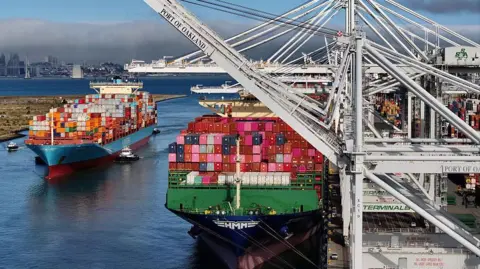On August 7, 2025, a significant escalation in trade tensions was marked by the introduction of sweeping new tariffs by President Donald Trump, creating ripples throughout the global economy. This decision represents an intensification of the ongoing trade war that the United States has been engaged in over recent years, reshaping international economic alliances.
Minutes before the midnight deadline in Washington, D.C., Trump announced on social media the initiation of the tariffs, declaring, “IT’S MIDNIGHT!!! BILLIONS OF DOLLARS IN TARIFFS ARE NOW FLOWING INTO THE UNITED STATES OF AMERICA!” This proclamation reflects his administration’s commitment to reasserting U.S. dominance in international trade. The latest tariffs are part and parcel of a strategy aimed primarily at reshaping the global trading system, which the President has frequently characterized as being unjust and disproportionately beneficial to other nations at the expense of American workers.
In this latest round, India finds itself in the crosshairs, facing a substantial new tariff of 50% which will be enforced from August 27, contingent on whether the country alters its purchase of Russian oil. Alongside this, Trump has threatened to impose a staggering 100% tariff on foreign-made computer chips, a move that is also aimed at persuading major technology companies, notably Apple, to ramp up domestic production. Just recently, Apple announced a groundbreaking $100 billion investment in the United States, likely spurred by pressure from the White House to drive more manufacturing stateside.
As the Trump administration rolled out the revised tariffs, countries around the globe have been scrambling to secure favorable trade agreements to mitigate the impact. Agreements have already commenced with major economies, including Japan, the United Kingdom, and South Korea, enabling them to secure lower tariffs compared to those previously threatened. The European Union likewise has managed to negotiate a framework deal, which saw a 15% tariff set on goods exported from the EU to the U.S.
The tariffs vary significantly based on the perceived alignment of countries with U.S. interests. For instance, Taiwan, recognized as a pivotal ally in the region, was assigned a temporary 20% tariff while discussions with U.S. authorities are still in motion according to President Lai Ching-te. In a different scenario, the Canadian government’s failure to clamp down on the flow of drugs, specifically fentanyl, across the U.S.-Canada border led Trump to raise tariffs on Canadian imports from 25% to 35%. However, it is noteworthy that most Canadian goods will avoid these tariffs thanks to the existing trade pact, the United States-Mexico-Canada Agreement (USMCA).
The rippling effects of these new tariffs are expected to disproportionately affect export-reliant economies in Southeast Asia, particularly manufacturing-centric countries like Laos and Myanmar, which are facing up to 40% in tariffs. Economists speculate that Trump’s policy choices are strategically directed at nations that maintain strong trade relationships with China, showcasing an underlying intent to reshape international alliances and practices.
Adding further complexity to the situation, just a week ago, Trump announced a 100% tariff on foreign-made semiconductors, a significant area in global tech. Major firms such as Taiwan Semiconductor Manufacturing Company (TSMC), SK Hynix, and Samsung have reportedly skirted these new tariffs due to their substantial investments in America, although the White House has yet to clarify these exemptions.
Furthermore, Brazil’s exports to the U.S. are also facing a newly imposed 50% tariff, resulting from accusations made by Trump against President Luiz Inacio Lula da Silva regarding unjust actions toward American tech firms. As tensions mount, U.S. and Chinese authorities are actively engaging in negotiations to extend a recently established pause on certain tariffs, indicating the precarious balance on which many economies are currently poised.
The landscape of international commerce is evolving quickly as these new tariffs unveil a new chapter in trade relations, leaving many countries to navigate the impounding complexities imposed by the U.S. policies under Donald Trump’s administration, ultimately affecting consumers and businesses alike on a global scale.











